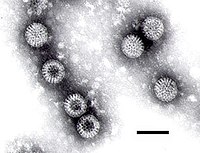
Photo from wikipedia
It is well-established that double-stranded RNA (dsRNA) exhibits noticeable radioprotective and radiotherapeutic effects. The experiments conducted in this study directly demonstrated that dsRNA was delivered into the cell in its… Click to show full abstract
It is well-established that double-stranded RNA (dsRNA) exhibits noticeable radioprotective and radiotherapeutic effects. The experiments conducted in this study directly demonstrated that dsRNA was delivered into the cell in its native form and that it induced hematopoietic progenitor proliferation. The 68 bp synthetic dsRNA labeled with 6-carboxyfluorescein (FAM) was internalized into mouse hematopoietic progenitors, c-Kit+ (a marker of long-term hematopoietic stem cells) cells and CD34+ (a marker of short-term hematopoietic stem cells and multipotent progenitors) cells. Treating bone marrow cells with dsRNA stimulated the growth of colonies, mainly cells of the granulocyte–macrophage lineage. A total of 0.8% of Krebs-2 cells internalized FAM-dsRNA and were simultaneously CD34+ cells. dsRNA in its native state was delivered into the cell, where it was present without any signs of processing. dsRNA binding to a cell was independent of cell charge. dsRNA internalization was related to the receptor-mediated process that requires energy from ATP. Synthetic dsRNA did not degrade in the bloodstream for at least 2 h. Hematopoietic precursors that had captured dsRNA reinfused into the bloodstream and populated the bone marrow and spleen. This study, for the first time, directly proved that synthetic dsRNA is internalized into a eukaryotic cell via a natural mechanism.
Journal Title: International Journal of Molecular Sciences
Year Published: 2023
Link to full text (if available)
Share on Social Media: Sign Up to like & get
recommendations!